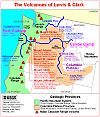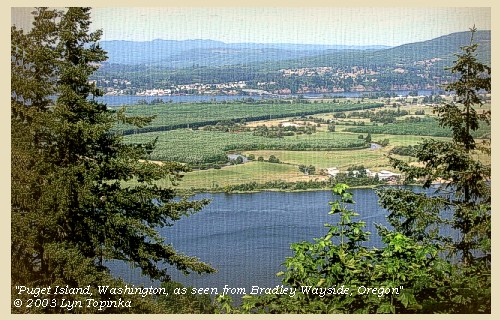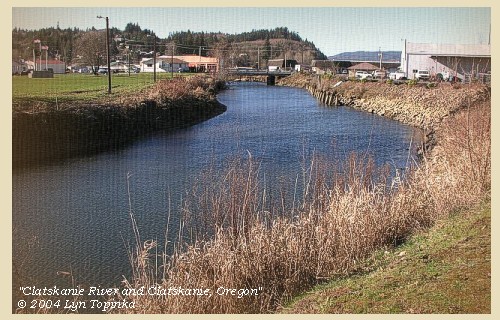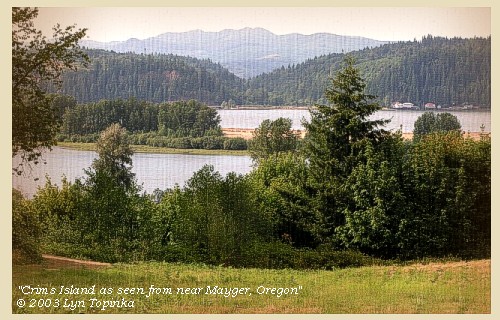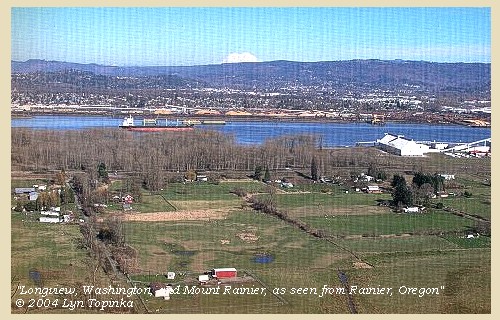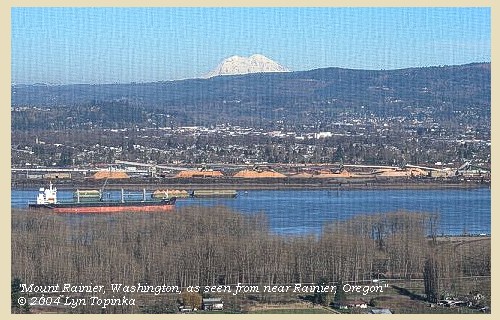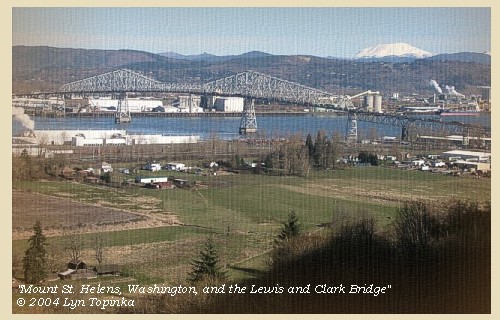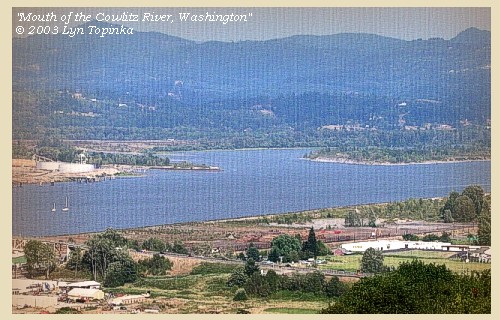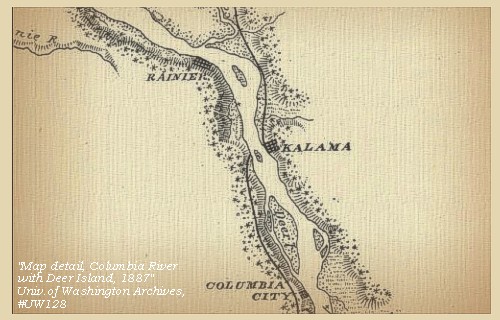The Volcanoes of
Lewis and Clark
Lewis and Clark
|
March 25 - 28, 1806 Heading Home - Puget Island to Deer Island |
|
Home
The Volcanoes of Lewis and Clark Map of the Journey Volcanoes, Basalt Plateaus, Major Rivers, etc. The Volcanoes Mount Adams, Mount Hood, Mount Jefferson, Mount Rainier, and Mount St. Helens CALENDAR of the Journey October 1805 to June 1806 Along the Journey Pacific Northwest Maps - Columbia River, Volcanoes, Flood Basalts, Missoula Floods, Geology, etc. The Corps of Discovery The Journey of Lewis and Clark About the Reference Materials The Journals, Biddle/Allen, DeVoto, Gass, Moulton, Topo Maps, and others USGS Lewis and Clark Links Links to USGS Websites highlighting the Lewis and Clark Journey Resources Publications Referenced and Websites Visited |
PREVIOUS
March 23-24 Heading Home, Fort Clatsop to Tenasillahe Island |
March 25-28
Heading Home, Puget Island to Deer Island Puget Island, Clatskanie River and Beaver Slough, Crims Island, Island above Crims, Longview (Washington) and Rainier (Oregon), Lewis and Clark Bridge, Mount Rainier and Mount St. Helens, Mount Coffin, Cowlitz River, Goble Volcanics, Deer Island |
CONTINUE
March 29 Heading Home, Deer Island to Ridgefield NWR |
|
Heading for Home - March 1806
Back on the Columbia - Puget Island to Deer Island |
| Lewis and Clark's camp of March 24, 1806, was on the Oregon side of the Columbia River, northeast of Brownsmead, at Aldrich Point, across from Tenasillahe Island. |
| Tuesday, March 25, 1806 |
| This morning proved so disagreeably cold that we did not set out before seven o'clock, when having breakfasted, we continued along the southern side of the river. The wind, however, as well as a strong current was against us, so that we proceeded slowly. On landing for dinner at noon, we were joined by some Clatsops ...... After dinner we crossed the river to a large island [Puget Island], along the side of which we continued ...... |
| We proceeded on to the head of the island [Puget Island], and then crossed to the north side of the river [some of the men, see below]. Here the coast formed a continued swamp for several miles back, so that it was late in the evening before we were able to reach a spot fit for our camp. |
| The Biddle/Allen publication is mis-leading -- according to the Journals as printed in Moulton, 1991, Vol.7, only three of the expedition traveled on the north side of the Columbia. The rest of the men were on the south side. The main camp for March 25, 1806, was near the Clastskanie River on the Oregon side. |
| "... Last night and this morning are cool wend hard a head and tide going out, after an early brackfast we proceeded on about 4 miles and came too on the South Side to worm and dry our Selves a little. ... as the wind was hard a head and tide against us we Concluded to delay untill the return of the tide which we expected at 1 oClock, at which hour we Set out ... we crossed over to an Island on which was a Cath lahmah fishing Camp of one Lodge; ... we remained at this place about half an hour and then Continued our rout. the winds in the evening was verry hard, it was with Some dificuelty that we Could find a Spot proper for an encampment, the Shore being a Swamp for Several miles back; at length late in the evening opposit to the place we had encamped on the 6th of Novr. last; we found the enterance of a Small Creek which offered us a Safe harbour from the Winds and Encamped. the Ground was low and moist tho' we obtained a tolerable encampment. ... here we found Drewyer and the 2 Fields' who had been Seperated from us Since Morning; they had passed on the North Side of the large Island which was much nearest. ... made 15 Miles ..." [Clark, March 25, 1806] |
| At length we discovered the entrance of a small creek [Clatskanie River/Beaver Slough], opposite to the place where we were encamped on the sixth of November [On the Washington side between Eagle Cliff and Cape Horn, across from Wallace Island], |
| and though the ground was low and moist, yet as the spot was sheltered from the wind, we resolved to pass the night there [near the Clatskanie River and the today's town of Clatskanie, Oregon]: we had now made fifteen miles. ...... The wind was very high towards evening. ...... |
|
|
|
The Camp - March 25, 1806:
Near the Clatskanie River and today's town of Clatskanie, Oregon. |
| Wednesday, March 26, 1806 |
| The wind ...... continued to blow so violent in the morning, that we could not set out before eight o'clock. ...... The wind having abated, we proceeded to an old village, where we halted for dinner [on the southern bank, opposite the west end of Crims Island], having met on the way Sahawacap the principal chief of all the Cathlamahs, who was on his return from a trading voyage up the river, with wappatoo and fish, some of which he gave us, and we purchased a little more. ...... After dinner we passed along the north shore opposite to a high fine bottom and dry prairie [today an area upstream of Clatskanie, Oregon, containing Beaver and McLean Sloughs], at the upper end of which, near a grove of white-oak trees, is an island which we called Fanny's island [Crims Island]. |
|
"...
The wind blew So hard untill 8 A M. that we detained, ...
we Continued our rout up the river to an old Village on the South Side where we halted for dinner ...
halted for dinner at an Old Village on the South point opposit the lower pt. of Fannys Island.
..."
[Clark, March 26, 1806] |
|
"...
after dinner we proceeded on and passed an Elegant and extensive
bottom on the South side and an island
near it's upper point which we call Fanny's Island and bottom.
the great part of the bottom is a high dry prarie.
..."
[Lewis, March 26, 1806] |
| There were some deer and elk at a distance in the prairie, but as we could not stay to hunt, we continued till late in the evening, when we encamped on the next island [possibly Walker Island or Dibblee (formerly Lord) islands] above Fanny's [Crims Island]. According to the estimate we made in descending the river, which we begin, however, to think was short, our journey of to-day was eighteen miles. ...... |
|
"...
after dinner I walked on Shore through an eligant bottom on the South Side opposit to Fannys Island. This bottom we also Call fannys bottom it is extensive and an open leavel plain except near the river bank which is high dry rich oak land. I saw Some deer & Elk at a distance in the Prarie. we continued untill late in the evening and encamped on a Small Island near the Middle of the river haveing made 18 Miles.
..."
[Clark, March 26, 1806] |
|
|
|
The Camp - March 26, 1806:
On an island in the middle of the Columbia River, in the vicinity of today's Walker Island. |
| Thursday, March 27, 1806 |
| We set out early, and were soon joined by some Skilloots, with fish and roots for sale. At ten o'clock we stopped to breakfast at two houses of the same nation, where we found our hunters, who had not returned to camp last night, but had killed nothing. The inhabitants seemed very kind and hospitable. ...... |
| Today, Longview, Washington, and Rainier, Oregon, are along this stretch of the Columbia. The Lewis and Clark Bridge connects the two cities. |
| If the day had been clear, Mount Rainier and Mount St. Helens would have been visible from the Oregon side of the Columbia River. |
| At the distance of two miles we passed the entrance of Coweliskee river [Cowlitz River]. This stream discharges itself on the north side of the Columbia, about three miles above a remarkably high rocky knoll [Mount Coffin], the south side of which it washes in passing, and which is separated from the northern hills by a wide bottom of several miles in extent. |
| The Coweliskee [Cowlitz River] is one hundred and fifty yards wide, deep and navigable, as the Indians assert, for a considerable distance, and most probably waters the country west and north of the range of mountains [Cascade Mountains] which cross the Columbia between the great falls and rapids. On the lower side of this river, a few miles from its entrance into the Columbia, is the principal village of the Skilloots, a numerous people ...... |
| Late in the evening we halted at the beginning of the bottom land, below Deer island [near Goble, Oregon, across from today's Sandy Island and Kalama, Washington], after having made twenty miles. |
| Along the low grounds on the river were the cottonwood, sweet-willow, the oak, ash, the broad-leafed ash, and the growth resembling the beech; while the hills are occupied almost exclusively by different species of fir, and the black alder is common to the hills as well as the low ground. ...... |
|
|
|
The Camp - March 27, 1806:
On the Oregon side of the Columbia River in the vicinity of Goble, across from today's Sandy Island and Kalama, Washington. |
| Friday, March 28, 1806 |
| We left our camp at an early hour, and by nine o'clock reached an old Indian village on the left side of Deer island [Deer Island]. Here we found a party of our men whom we had sent on yesterday to hunt ...... This island, which has received from the Indians the appropriate name of Elalah, or Deer island, is surrounded on the water side by an abundant growth of cotton-wood, ash, and willow, while the interior consists chiefly of prairies interspersed with ponds. ...... |
| We had advanced only five miles to-day. |
|
|
|
The Camp - March 28, 1806:
On the eastern shore of Deer Island, towards the northern tip. There is a Highway marker on U.S. Highway 30. |
| Home | Previous | Continue |
If you have questions or comments please contact: GS-CVO-WEB@usgs.gov
June/July 2004, Lyn Topinka
The Volcanoes of Lewis and Clark Home Page | CVO Home Page

